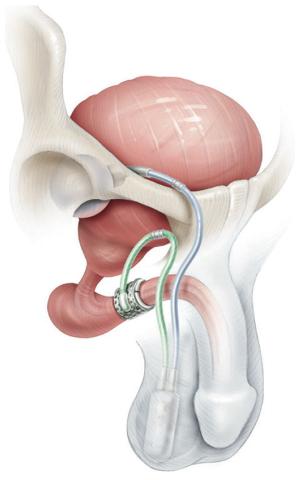This is a prosthesis (implant) that acts as an artificial valve to control the passage of urine from the bladder - it restores continence, and offers an alternative to pads and catheters as a treatment for urinary incontinence.
What happens during the procedure?
-
You will receive a full general anaesthetic - you may also receive an epidural (spinal) as well.
-
You will be given intravenous antibiotics before and after the procedure.
-
You will have a small incision between the scrotum and the anus (the perineum) to allow the cuff to be placed around the urethra.
-
A second incision is made in the groin to position the reservoir and pump.
-
Occasionally a single incision is made in the scrotum.
-
Your doctor will inform you the most appropriate incision for your situation.
AMS 800 – Artificial Urinary Sphincter

The AMS 800 artificial urinary sphincter (AUS) is regarded as the gold standard in the treatment of urinary incontinence, especially in males. This is what is inserted during your operation.
It consists of three components:
-
Cuff – this is the circular, fluid-filled, inflatable component that wraps around the urethra - the tube you pass your urine through.
-
Pump – this is sited in the scrotum, and is the device that opens the cuff to allow you to pass urine.
-
Reservoir – this is the small pressure-regulated balloon positioned under the abdominal wall.
Side Effects
All operations have the potential for side effects. Most people do not experience any (< 10% of patients actually do), though it is good to be aware of what they might be:
Occasional - < 10%
-
Burning or blood when you pass urine – usually settles in a few days.
-
Temporary insertion of catheter.
-
Mechanical failure.
-
Infection.
Uncommon - < 5%
-
Cuff loosening resulting in returned incontinence.
-
Urine infection.
Rare - < 1%
-
Wound infection.
-
Erosion of cuff exposing the device to urine.
